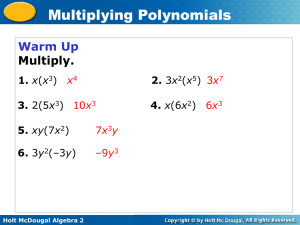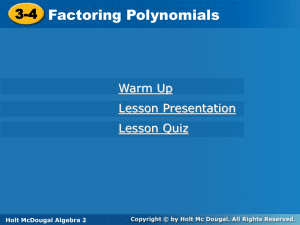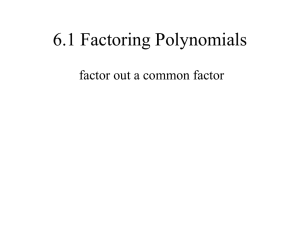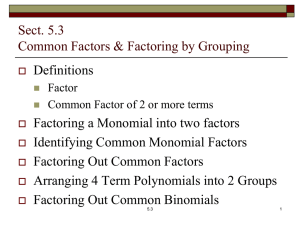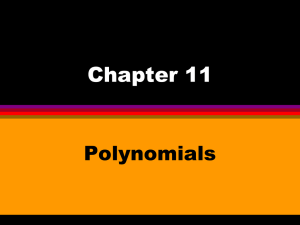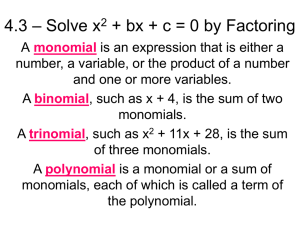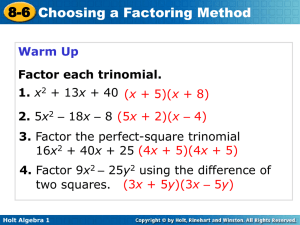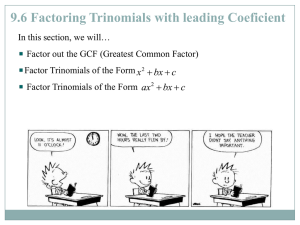2. x - Biloxi Public Schools
advertisement
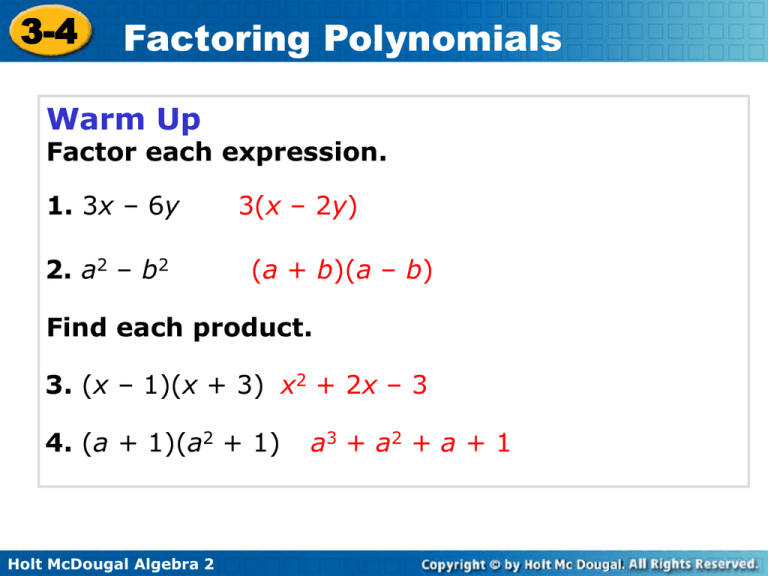
3-4 Factoring Polynomials Warm Up Factor each expression. 1. 3x – 6y 2. a2 – b2 3(x – 2y) (a + b)(a – b) Find each product. 3. (x – 1)(x + 3) x2 + 2x – 3 4. (a + 1)(a2 + 1) Holt McDougal Algebra 2 a3 + a2 + a + 1 3-4 Factoring Polynomials Objectives Use the Factor Theorem to determine factors of a polynomial. Factor the sum and difference of two cubes. Holt McDougal Algebra 2 3-4 Factoring Polynomials Recall that if a number is divided by any of its factors, the remainder is 0. Likewise, if a polynomial is divided by any of its factors, the remainder is 0. The Remainder Theorem states that if a polynomial is divided by (x – a), the remainder is the value of the function at a. So, if (x – a) is a factor of P(x), then P(a) = 0. Holt McDougal Algebra 2 3-4 Factoring Polynomials Example 1: Determining Whether a Linear Binomial is a Factor Determine whether the given binomial is a factor of the polynomial P(x). A. (x + 1); (x2 – 3x + 1) Find P(–1) by synthetic substitution. –1 1 –3 1 1 –1 –4 4 5 P(–1) = 5 P(–1) ≠ 0, so (x + 1) is not a factor of P(x) = x2 – 3x + 1. Holt McDougal Algebra 2 B. (x + 2); (3x4 + 6x3 – 5x – 10) Find P(–2) by synthetic substitution. –2 3 6 0 –5 –10 –6 0 0 3 0 0 –5 10 0 P(–2) = 0, so (x + 2) is a factor of P(x) = 3x4 + 6x3 – 5x – 10. 3-4 Factoring Polynomials Check It Out! Example 1 Determine whether the given binomial is a factor of the polynomial P(x). a. (x + 2); (4x2 – 2x + 5) Find P(–2) by synthetic substitution. –2 4 –2 5 4 –8 20 –10 25 P(–2) = 25 P(–2) ≠ 0, so (x + 2) is not a factor of P(x) = 4x2 – 2x + 5. Holt McDougal Algebra 2 b. (3x – 6); (3x4 – 6x3 + 6x2 + 3x – 30) Divide the polynomial by 3, then find P(2) by synthetic substitution. 2 1 –2 2 1 –10 1 2 0 4 10 0 2 5 0 P(2) = 0, so (3x – 6) is a factor of P(x) = 3x4 – 6x3 + 6x2 + 3x – 30. 3-4 Factoring Polynomials You are already familiar with methods for factoring quadratic expressions. You can factor polynomials of higher degrees using many of the same methods you learned in Lesson 5-3. Holt McDougal Algebra 2 3-4 Factoring Polynomials Example 2: Factoring by Grouping Factor: x3 – x2 – 25x + 25. (x3 – x2) + (–25x + 25) x2(x – 1) – 25(x – 1) Group terms. Factor common monomials from each group. (x – 1)(x2 – 25) Factor out the common binomial (x – 1). (x – 1)(x – 5)(x + 5) Factor the difference of squares. Holt McDougal Algebra 2 3-4 Factoring Polynomials Example 2 Continued Check Use the table feature of your calculator to compare the original expression and the factored form. The table shows that the original function and the factored form have the same function values. Holt McDougal Algebra 2 3-4 Factoring Polynomials Check It Out! Example 2a Factor: x3 – 2x2 – 9x + 18. (x3 – 2x2) + (–9x + 18) x2(x – 2) – 9(x – 2) Group terms. Factor common monomials from each group. (x – 2)(x2 – 9) Factor out the common binomial (x – 2). (x – 2)(x – 3)(x + 3) Factor the difference of squares. Holt McDougal Algebra 2 3-4 Factoring Polynomials Check It Out! Example 2a Continued Check Use the table feature of your calculator to compare the original expression and the factored form. The table shows that the original function and the factored form have the same function values. Holt McDougal Algebra 2 3-4 Factoring Polynomials Check It Out! Example 2b Factor: 2x3 + x2 + 8x + 4. (2x3 + x2) + (8x + 4) x2(2x + 1) + 4(2x + 1) Group terms. Factor common monomials from each group. (2x + 1)(x2 + 4) Factor out the common binomial (2x + 1). (2x + 1)(x2 + 4) Holt McDougal Algebra 2 3-4 Factoring Polynomials Just as there is a special rule for factoring the difference of two squares, there are special rules for factoring the sum or difference of two cubes. Holt McDougal Algebra 2 3-4 Factoring Polynomials Example 3A: Factoring the Sum or Difference of Two Cubes Factor the expression. 4x4 + 108x 4x(x3 + 27) Factor out the GCF, 4x. 4x(x3 + 33) Rewrite as the sum of cubes. 4x(x + 3)(x2 –x3+ 32) 4x(x + 3)(x2 – 3x + 9) Holt McDougal Algebra 2 Use the rule a3 + b3 = (a + b) (a2 – ab + b2). 3-4 Factoring Polynomials Example 3B: Factoring the Sum or Difference of Two Cubes Factor the expression. 125d3 – 8 Rewrite as the difference of cubes. (5d – 2)[(5d)2 + 5d 2 + 22] Use the rule a3 – b3 = (a – b) (a2 + ab + b2). (5d)3 – 23 (5d – 2)(25d2 + 10d + 4) Holt McDougal Algebra 2 3-4 Factoring Polynomials Check It Out! Example 3a Factor the expression. 8 + z6 (2)3 + (z2)3 (2 + z2)[(2)2 – 2 z + (z2)2] (2 + z2)(4 – 2z + z4) Holt McDougal Algebra 2 Rewrite as the difference of cubes. Use the rule a3 + b3 = (a + b) (a2 – ab + b2). 3-4 Factoring Polynomials Check It Out! Example 3b Factor the expression. 2x5 – 16x2 2x2(x3 – 8) Factor out the GCF, 2x2. Rewrite as the difference of cubes. 2x2(x3 – 23) 2x2(x – 2)(x2 +x2+ 22) 2x2(x – 2)(x2 + 2x + 4) Holt McDougal Algebra 2 Use the rule a3 – b3 = (a – b) (a2 + ab + b2). 3-4 Factoring Polynomials Example 4: Geometry Application The volume of a plastic storage box is modeled by the function V(x) = x3 + 6x2 + 3x – 10. Identify the values of x for which V(x) = 0, then use the graph to factor V(x). V(x) has three real zeros at x = –5, x = –2, and x = 1. If the model is accurate, the box will have no volume if x = –5, x = –2, or x = 1. Holt McDougal Algebra 2 3-4 Factoring Polynomials Example 4 Continued One corresponding factor is (x – 1). 1 1 6 3 –10 1 7 10 1 7 10 0 Use synthetic division to factor the polynomial. V(x)= (x – 1)(x2 + 7x + 10) Write V(x) as a product. V(x)= (x – 1)(x + 2)(x + 5) Factor the quadratic. Holt McDougal Algebra 2 3-4 Factoring Polynomials Check It Out! Example 4 The volume of a rectangular prism is modeled by the function V(x) = x3 – 8x2 + 19x – 12, which is graphed below. Identify the values of x for which V(x) = 0, then use the graph to factor V(x). V(x) has three real zeros at x = 1, x = 3, and x = 4. If the model is accurate, the box will have no volume if x = 1, x = 3, or x = 4. Holt McDougal Algebra 2 3-4 Factoring Polynomials Check It Out! Example 4 Continued One corresponding factor is (x – 1). 1 1 –8 19 –12 1 –7 1 –7 12 12 0 Use synthetic division to factor the polynomial. V(x)= (x – 1)(x2 – 7x + 12) Write V(x) as a product. V(x)= (x – 1)(x – 3)(x – 4) Holt McDougal Algebra 2 Factor the quadratic. 3-4 Factoring Polynomials Lesson Quiz 1. x – 1; P(x) = 3x2 – 2x + 5 P(1) ≠ 0, so x – 1 is not a factor of P(x). 2. x + 2; P(x) = x3 + 2x2 – x – 2 P(2) = 0, so x + 2 is a factor of P(x). 3. x3 + 3x2 – 9x – 27 (x + 3)(x + 3)(x – 3) 4. x3 + 3x2 – 28x – 60 (x + 6)(x – 5)(x + 2) 4. 64p3 – 8q3 Holt McDougal Algebra 2 8(2p – q)(4p2 + 2pq + q2)
